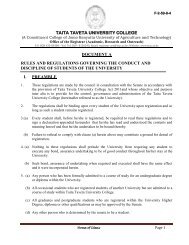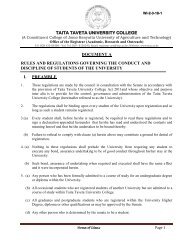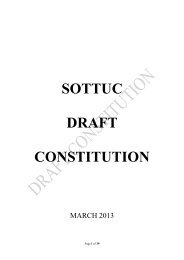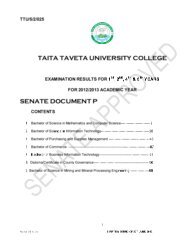Conference Book of Abstracts - Taita Taveta University College
Conference Book of Abstracts - Taita Taveta University College
Conference Book of Abstracts - Taita Taveta University College
- No tags were found...
Create successful ePaper yourself
Turn your PDF publications into a flip-book with our unique Google optimized e-Paper software.
Notably though, the Kenya coastal forests are facing unprecedented threats from bothanthropogenic and natural forces. The threats on coastal forests include: excision, unsustainableforest resource collection, charcoal burning, industrialization, urbanization and mining, amongothers. These threats are caused partly by - increased human population and activities; poverty,unregulated use <strong>of</strong> forest resources, insufficient local and national institutional capacities, policygaps and weaknesses, lack <strong>of</strong> alternative means <strong>of</strong> livelihood, among others. These threats arecompounded by the effects <strong>of</strong> the rather new concept <strong>of</strong> climate change on Forests, which mayresult in unprecedented scenario in forest conservation, details <strong>of</strong> which may not be clearlypredicted nor comprehended. Given that Kenya is entering the devolved governance system, anda considerable responsibility <strong>of</strong> Environmental policy formulation will be shouldered on theCounty Governments, chances are that the Kenya Coastal forests will be managed in a discrete,myopic approach, serving the limited interests and understanding <strong>of</strong> the Counties. Consideringthe historical sectarian management <strong>of</strong> natural resources in Kenya, the Kenya Coastal Forestspatches are further likely to be segmented from an ecosystem perspective to forest fragments thatlack continuity or connections.The opportunities for conservation <strong>of</strong> Kenya Coastal forests lie in the reviewed managementregime, where regions are likely to take lead in conserving their ecological areas. The KFS hasalso mainstreamed Participatory Forest Management (PFM) system and increased communityparticipation in forest management through FCCs and CFAs. This is a positive score as theKenya Coastal communities have from time immemorial been custodians and conservationists <strong>of</strong>the forests. There is also an increased interest in conservation by various institutions (researchand academic institutions, government and non-government organizations). Institutions <strong>of</strong> higherlearning, e.g. Pwani <strong>University</strong> <strong>College</strong>, have included Botanic Garden with IK and Biodiversityconservation as one <strong>of</strong> the indices for their performance evaluation.ReferencesBurgess, N.D., G.P. Clarke, & W.A. Rodgers. 1998c. Coastal Forests <strong>of</strong> eastern Africa: status, species endemismand its possible causes. Biological Journal <strong>of</strong> the Linnean Society 64: 337–367.Janzen, D.H. 1988. Management <strong>of</strong> habitat fragments in tropical dry forests. Annals Missouri Botanical Garden 75:105-106.Kokwaro, J.O. 1976. Medicinal Plants <strong>of</strong> East Africa. East African Literature Bureau, Nairobi, Kenya.Pakia M. & JA. Cooke 2003. The ethnobotany <strong>of</strong> the Midzichenda tribes <strong>of</strong> the coastal forest areas in Kenya: 1.General perspective and non-medicinal plant uses. South African Journal <strong>of</strong> Botany 69 (3): 370- 381.Robertson, S.A. & W. R.Q. Luke. 1993. Kenya Coastal Forests. WWF, Nairobi.
















